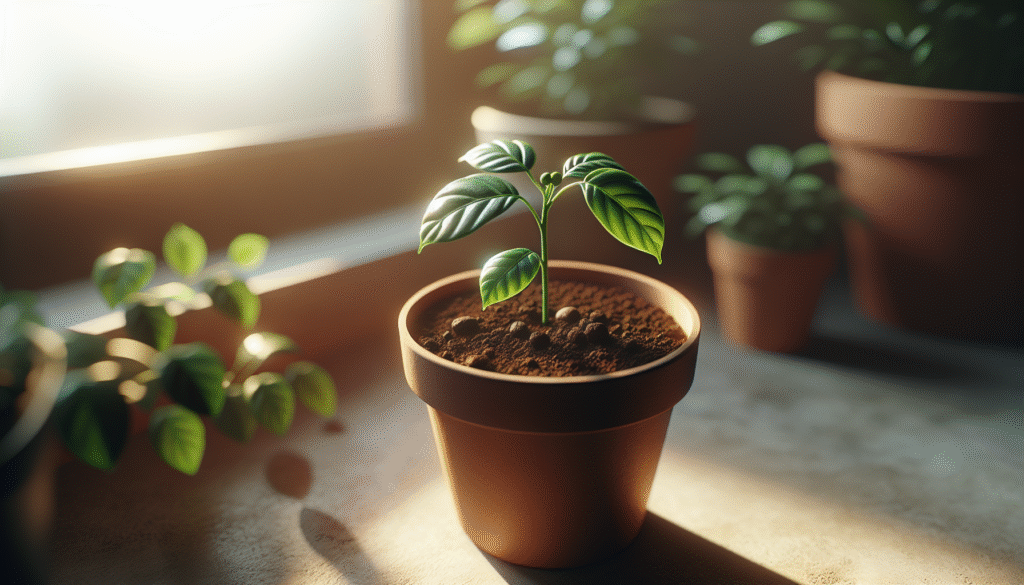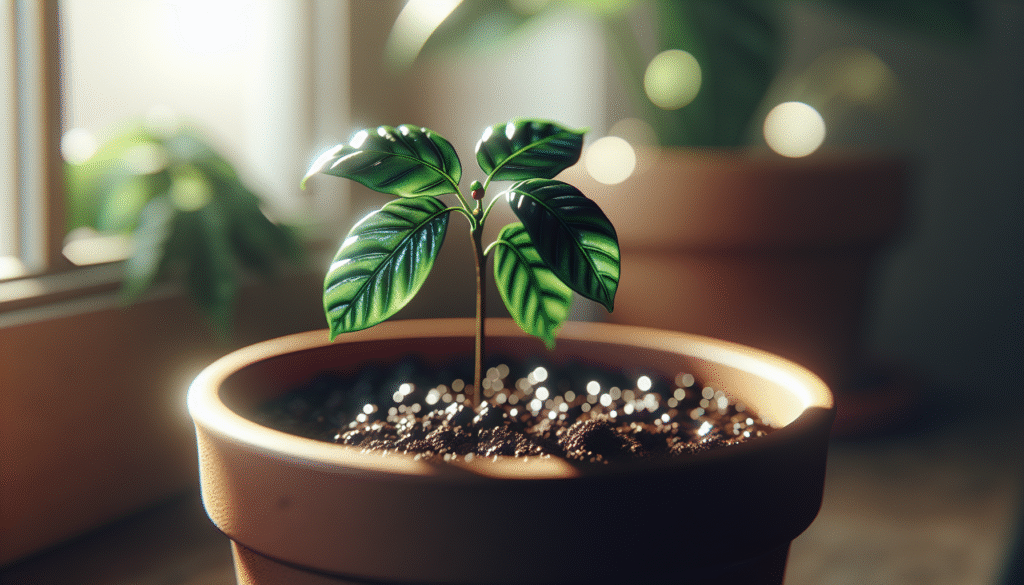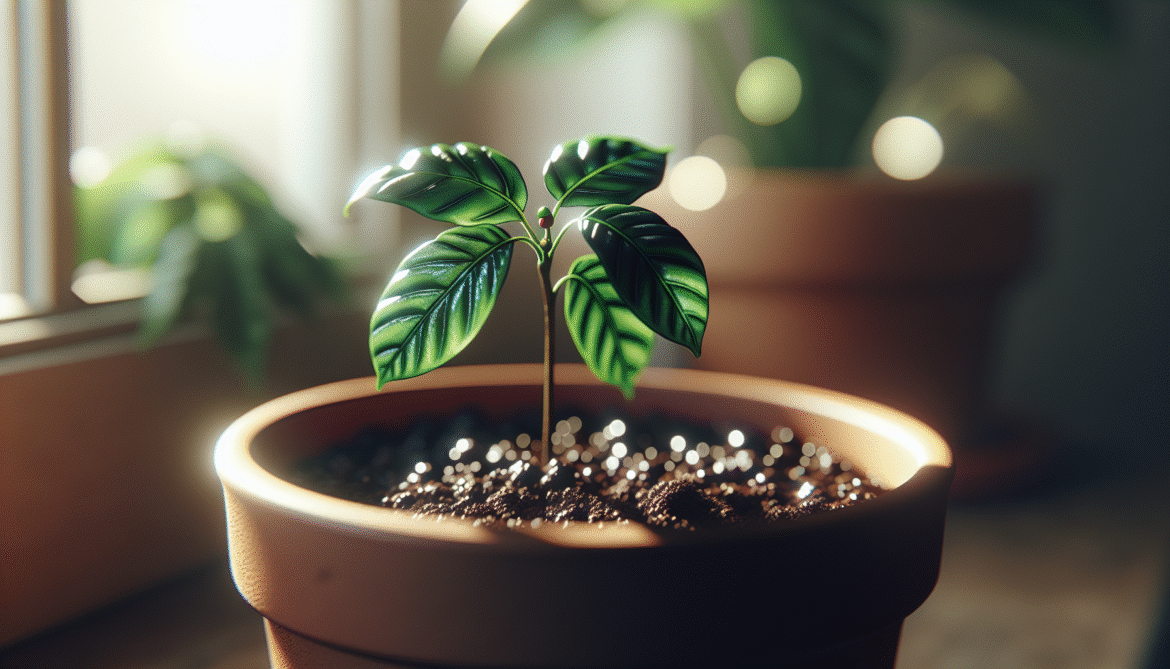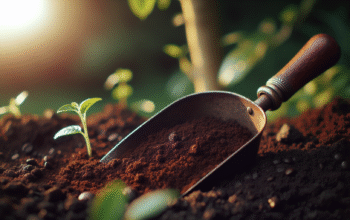?Have you ever thought about growing a coffee bean plant in your home garden so you can enjoy the beauty of its glossy leaves, fragrant white flowers, and eventually your own coffee cherries?

Nurturing the Coffee Bean Plant for Home Gardens
This guide walks you through everything you need to know to successfully grow the coffee bean plant in containers or your garden. You’ll learn how to choose a variety, start from seed or seedling, meet light, water, soil, and humidity needs, manage pests, and harvest and process your cherries for a small-batch cup at home.
Why grow a coffee bean plant at home?
Growing coffee at home gives you a living houseplant that also produces edible cherries and fragrant flowers. You’ll appreciate the ornamental value, the hands-on learning, and the satisfaction of producing a crop — even if it’s small. For many home gardeners, the plant also becomes a conversation starter and a rewarding long-term hobby.
Choosing the right coffee species and variety
Picking the appropriate species and variety is one of the most important early decisions you’ll make. The two most commonly grown species are Coffea arabica (Arabica) and Coffea canephora (Robusta), each with different growing needs and flavor profiles.
Arabica vs Robusta: key differences
Arabica generally has a sweeter, more complex cup and prefers cooler, higher-altitude conditions with stable temperatures. Robusta tolerates warmer conditions, is more disease resistant, and produces more caffeine with a harsher cup. Choose Arabica for quality and indoor/container settings; choose Robusta if you have a hot, humid outdoor garden or need a hardier plant.
Popular varieties for home gardens
There are many named cultivars, such as Typica and Bourbon for Arabica, and hardy Robusta types for low-maintenance growth. For most home gardeners, disease-resistant Arabica varieties from nurseries or specialty suppliers are best because they balance flavor and manageability.
Buying seedlings vs starting from seed
Deciding whether to start from seed or to buy an established seedling affects how quickly you’ll see growth and fruiting. Each approach has pros and cons.
Pros and cons of seedlings
Buying a young plant gives you a head start, earlier flowering, and lower initial failure risk. You pay more, but you avoid the slow, sometimes finicky germination phase. Seedlings also let you choose known cultivars that have desirable traits.
Pros and cons of starting from seed
Starting from seed is satisfying and often less expensive. However, seeds must be fresh and viable to germinate reliably. You’ll need patience: from seed to first crop can take several years. Growing from seed can also yield genetic variation for heirloom exploration.
Sourcing healthy coffee plants and seeds
Where you obtain your plants matters for health, variety, and success. Reputable nurseries and specialty online sellers are your best sources.
What to look for when buying seedlings
Choose plants with glossy, dark green leaves, sturdy stems, and no visible pests or fungal spots. Avoid plants with extensive yellowing, wilting, or root-bound conditions if they are in small pots.
How to pick viable seeds
Seeds should be fresh within months of harvest; they lose viability quickly if dried or stored poorly. Look for plump, intact seeds and buy from trusted providers that store and ship seeds properly.
Germination and early care
If you start from seed, germination requires consistent warmth, humidity, and a shaded environment. Early care will set the stage for a healthy, productive plant.
Preparing seeds and the medium
Soak seeds briefly in lukewarm water to soften the outer coating, then plant them in a well-draining mix with some organic matter. Keep the medium moist but never waterlogged. Germination can take 2–8 weeks depending on seed freshness and conditions.
Ideal germination conditions
Maintain temperatures around 20–25°C (68–77°F) and high humidity. You can use a humidity dome or place seed trays in a warm, shaded spot. Avoid direct sun; seedlings are sensitive to harsh light.
Soil and potting mix requirements
Coffee plants prefer a rich, loose, well-draining medium that retains some moisture without becoming waterlogged. Good soil is foundational to plant health.
Best soil composition
Aim for a mix of quality potting soil, compost, and materials that improve drainage like perlite or coarse sand. A slightly acidic pH between 6.0 and 6.5 suits Arabica well. If your tap water is very alkaline, amending soil with peat, composted bark, or sulfur can help maintain acidity.
Container size and drainage
Choose a container with good drainage holes and size it so roots have room to expand by about 25–30% beyond the rootball. Start in smaller pots and gradually upsize; overly large pots can retain too much water and slow growth.
Light requirements
Light is crucial but coffee plants prefer bright, indirect light rather than full sun. You’ll need to balance light exposure with the plant’s tropical understory origins.
Indoor light guidelines
Place plants near an east- or north-facing window for bright but indirect light. If you only have south- or west-facing windows, use sheer curtains to filter light. Supplemental grow lights can help during darker months or in low-light homes.
Outdoor light guidelines
If you grow your coffee plant outdoors, give it morning sun and afternoon shade, or plant it under dappled canopy conditions. Avoid prolonged midday sun exposure, which can scorch leaves, especially for young plants.
Temperature and humidity
Mimicking tropical understory conditions — consistent temperatures and high humidity — will keep your coffee plant happy. Fluctuating or extreme conditions stress the plant and reduce flowering.
Ideal temperature range
Maintain daytime temperatures between 18–24°C (64–75°F) with nighttime not falling below 13°C (55°F) for Arabica. Robusta tolerates warmer ranges. Avoid drafts and sudden temperature swings.
Managing humidity
Aim for relative humidity of 60–80% if possible. You can raise humidity with pebble trays, humidifiers, or grouping plants together. Regular misting helps but does not replace consistent ambient humidity.
Watering: frequency and techniques
Understanding how to water is one of the most common hurdles. Overwatering causes root rot; underwatering causes leaf drop and reduced growth.
How often to water
Let the top 2–3 cm (about 1 inch) of potting mix dry before watering again, then water thoroughly until it drains from the bottom. In summer or heated indoor conditions you’ll water more often; in cooler, more humid times you’ll water less.
Water quality and temperature
Use room-temperature water to avoid shocking roots. If possible, use filtered, rainwater, or water that is low in dissolved salts and chlorine. If your water is hard, occasional flushing of the pot with clean water can prevent salt buildup.
Fertilizing and feeding schedule
Coffee plants are moderate feeders and benefit from regular, balanced fertilization to support green growth and fruiting. You can tune feed based on growth and season.
Fertilizer types and frequency
Use a balanced, slow-release fertilizer or liquid feed with an N-P-K ratio around 10-10-10 during the growing season. Feed every 4–6 weeks during spring and summer, and reduce feeding in fall and winter when growth slows. You can also use a higher-nitrogen mix in spring for leaf growth, then a bloom/fruit formula with slightly higher phosphorus when flowering begins.
Organic options
Compost, worm castings, fish emulsion, and well-rotted manure are excellent organic alternatives that also improve soil structure. Apply them sparingly and monitor plant response.
Pruning and training
Pruning helps maintain size, promote branching, and remove dead or crossing branches. Training affects shape and airflow, both important for a healthy plant.
When and how to prune
Prune lightly after major flushes or at the start of the growing season to shape the plant and encourage lateral growth. Remove dead wood and any suckers at the base if you want a single-stem form. For a bushier plant, pinch back new shoots to two pairs of leaves.
Training for containers
Keep the plant compact with periodic pruning, and avoid letting it get so tall that it becomes top-heavy or spindly. Use stakes or soft ties for support if needed, and repot before the root system becomes pot-bound.
Flowering and fruiting cycle
Knowing what to expect helps you recognize when your plant is healthy. Flowering is dramatic and fragrant; fruiting is a slow process.
Flowering cues and timing
White, jasmine-like flowers appear on new wood after periods of consistent moisture followed by a slight drying. Flowering typically occurs once or twice a year, but can be irregular in containers. Pollination is usually self-fertile, but having multiple plants increases fruit set.
From flower to cherry
After flowering, cherries take several months to ripen — often 6–9 months depending on conditions and species. Cherries change color from green to red, yellow, or orange depending on the variety, indicating ripeness.
Harvesting and processing your cherries
Harvesting at the right time and processing cherries properly determines the final flavor of your coffee.
When to harvest
Pick cherries when they are fully colored and slightly soft to the touch. Ripe cherries yield better flavor. For home use, hand-picking selective ripening gives the best results.
Basic processing methods
You’ll find two primary home-scale methods: wet (washed) processing and dry (natural) processing. Washed processing involves pulping the cherries, fermenting to remove mucilage, washing, and drying the beans. Natural processing dries whole cherries before removing the dried flesh. Each method produces different flavor profiles and requires careful drying to avoid mold.
Drying, hulling, and storing green beans
After processing, drying beans properly and storing them correctly extends their shelf life and preserves quality.
Drying methods
Dry beans on drying racks or clean trays with good airflow until they reach around 10–12% moisture content. Avoid direct sun exposure that overheats beans; rotate them frequently for even drying. Solar drying with a covered tray works well in many home setups.
Hulling and storage
Once sufficiently dry, remove the parchment or dried fruit layer (hulling). Store green beans in airtight containers in a cool, dark place. Properly stored green beans can last many months. Roast them when you’re ready for maximum freshness.

Roasting basics for home growers
Roasting is the final step that transforms green beans into drinkable coffee and also allows you to personalize flavor.
Small-batch roasting options
You can roast with a dedicated home roaster, a cast-iron skillet, or an oven or stovetop popcorn popper. Each method requires careful attention to temperature and color changes. Start small, take notes, and gradually refine your profiles.
Roast levels and flavor
Lighter roasts retain origin flavors (fruity, floral, acidic notes) while darker roasts develop chocolatey, smoky flavors but can mask origin nuances. Roast to taste and remember that freshly roasted beans need a short rest (degassing period) before brewing.
Pests and diseases: identification and control
Coffee plants can be susceptible to common pests and fungal diseases, but timely action and good cultural practices keep problems manageable.
Common pests
Pests include scale, mealybugs, aphids, spider mites, and whiteflies. Check the undersides of leaves and new growth frequently. A strong spray of water, insecticidal soap, neem oil, or beneficial insects can control infestations. Quarantine new plants to prevent introducing pests.
Common diseases
Leaf rust (Hemileia vastatrix), root rot (Phytophthora), and fungal leaf spots are among common issues. Maintain good airflow, avoid overwatering, and use disease-resistant varieties when possible. Fungicides or biological controls may be needed for severe outbreaks.
Table: Quick reference for pests and control
| Pest/Disease | Signs to watch for | Control measures |
|---|---|---|
| Scale & mealybug | Sticky honeydew, white cottony masses | Wipe with alcohol, insecticidal soap, neem oil |
| Spider mites | Webbing, stippled leaves, yellowing | Increase humidity, spray water, miticide if severe |
| Aphids | Clusters on new growth, distorted leaves | Blast with water, introduce predators, insecticidal soap |
| Leaf rust | Orange/yellow powdery spots on underside | Prune affected leaves, increase airflow, fungicide |
| Root rot | Wilting despite wet soil, brown roots | Improve drainage, repot, fungicide, reduce watering |
Troubleshooting common problems
When you spot symptoms, early diagnosis helps you correct them before major damage.
Yellowing leaves
Yellowing often indicates overwatering, poor drainage, or nutrient deficiencies. Check the root system, adjust watering, and apply balanced fertilizer if needed.
Leaf drop or poor growth
Sudden leaf drop can be caused by low humidity, temperature stress, or repotting shock. Stabilize conditions, raise humidity, and avoid dramatic changes in light or placement.
Scorched or brown leaf edges
Brown or crisp leaf margins usually mean too much direct sun, underwatering, or salt accumulation. Move the plant to a shadier spot, check watering, and flush the soil periodically to remove salts.
Propagation: cuttings, air-layering, and division
If you want more plants, several propagation methods work well for coffee.
Stem cuttings
Take semi-hardwood cuttings with a few nodes and leaves, insert into a moist rooting medium, and keep humid until roots develop. Use rooting hormone to improve success rates.
Air-layering
Air-layering yields larger, established plantlets. Girdle a healthy branch, apply rooting compound, wrap with moist sphagnum moss and plastic, and wait for roots before cutting and potting up.
Division and basal shoots
Some plants produce basal shoots or suckers that you can remove with roots attached. Replant these smaller plants in fresh mix and treat them as young seedlings.
Growing coffee outdoors vs containers
Whether you plant in the ground or in containers depends on your climate and space.
Container gardening advantages
Containers let you control soil, move plants to ideal light, and protect them from cold. They’re excellent for balconies, patios, and indoor living rooms.
Outdoor planting considerations
If you live in USDA zones typically 10–12 (or equivalent), you may plant outdoors. Ensure partial shade, well-draining soil, and protection from wind and temperature extremes. In cooler zones, grow in containers and move plants indoors for winter.
Seasonal care and overwintering
Seasonal routines keep your coffee plant thriving year-round, and overwintering is crucial in cooler climates.
Seasonal care calendar
Increase watering and feeding in spring and summer, reduce in autumn and winter. Prune after heavy growth periods to shape before the next season.
Overwintering tips
Move container plants indoors before the first cold nights. Provide bright, indirect light, stable temperatures, and maintain humidity. Reduce watering slightly while avoiding complete dryness.
Companion planting and landscape use
Coffee plants can integrate into mixed gardens and act as attractive understorey specimens.
Good companions
Shade-loving ornamentals, ferns, and edible understory plants like turmeric or ginger pair well. Avoid aggressive roots or species that attract severe pests.
Landscape roles
Use coffee plants as focal container specimens or as part of a shaded garden bed where their glossy foliage and flowers add texture and scent.
Ethical and sustainable considerations
Growing coffee at home gives you unique control but it also connects you to broader sustainability topics.
Ethical seed and plant sourcing
Choose suppliers who practice sustainable and fair labor practices. Avoid illegally collected wild plants and support nurseries that propagate responsibly.
Water and energy use
Be mindful of water usage, especially during processing and drying. Use efficient irrigation, composting, and reuse practices to reduce environmental impact.
Uses beyond the cup
Coffee cherries, leaves, and grounds have multiple uses beyond roasted coffee.
Culinary and household uses
Coffee leaves can be brewed as a mild herbal tea in some cultures. Spent grounds are excellent for compost, pest deterrence in the garden, and natural deodorizing. Dried cherries or cascara can be steeped as a fruity tea.
Educational and decorative uses
Your plant offers botanical learning opportunities and attractive foliage for interiors. The fragrant flowers make it a delightful houseplant even before you harvest.
Frequently asked questions (FAQs)
This section answers common quick questions so you can act fast when issues pop up.
How long until my plant produces cherries?
From seed, expect 3–5 years before consistent fruiting; seedlings may crop sooner. Time to first harvest depends on species, growing conditions, and care.
Can coffee plants survive in low-light apartments?
They can survive but will grow more slowly and may not flower or fruit reliably. Provide the brightest indirect light you can, or supplement with grow lights.
Is pruning necessary for fruiting?
Moderate pruning helps shape the plant and encourages branching which can increase flowering sites. Avoid heavy pruning during peak flower or fruit set.
Final tips and encouragement
Growing a coffee bean plant is a long-term, rewarding process that blends ornamental gardening with light-scale agriculture. Be patient, observe your plant closely, adapt care to its needs, and enjoy the sensory rewards of flowers and the possibility of homegrown cherries. Over time you’ll refine your routine and may find roasting and brewing your own small batch of coffee to be an immensely satisfying culmination of your gardening efforts.
If you’d like, you can tell me about your climate, available space, or whether you prefer Arabica or Robusta, and I’ll help you create a personalized care plan for your coffee bean plant.



